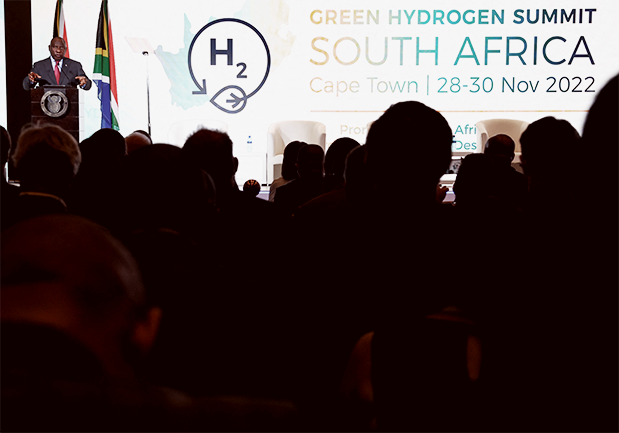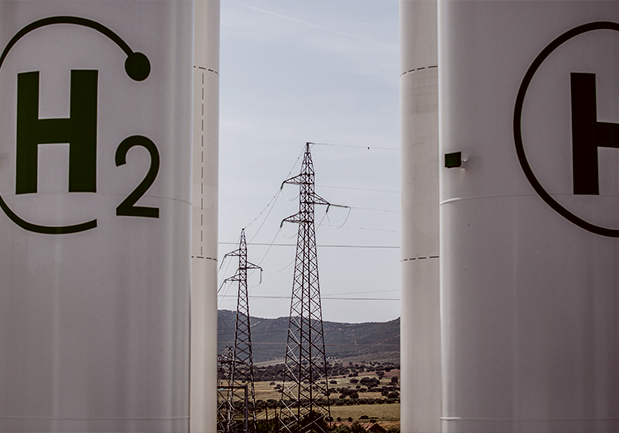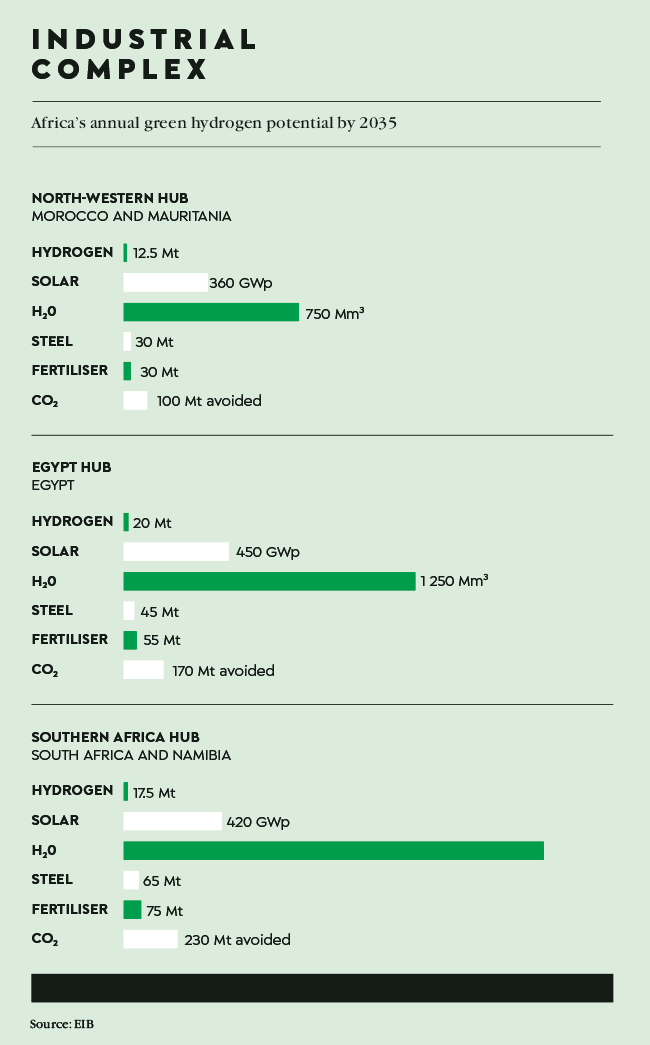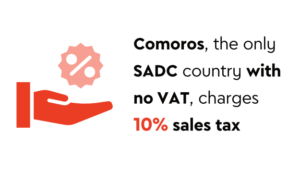It’s easy to see the attraction of hydrogen fuel. It produces three times more energy per unit than fossil fuels, and can rapidly decarbonise heavy industry and transportation, while also delivering electricity to some of the world’s hardest-to-electrify places.
Hydrogen fuel is produced by using electrolysers to split water (H2O) into hydrogen (H) and oxygen (O). And while nearly all the world’s hydrogen is currently ‘grey’ (produced using energy derived from hydrocarbons), if you use renewable energy to power the process, that grey hydrogen becomes green hydrogen … and that’s the real prize. Green hydrogen is clean, sustainable and renewable, and it costs less than natural gas. And its only byproduct is water.
And that’s why – from Chile to China and from Europe to Australia – governments are investing heavily in ‘hydrogen valleys’ – areas that draw on renewable resources such as wind, solar, hydro and geothermal energy to produce green hydrogen at scale. The International Renewable Energy Agency calls green hydrogen ‘an essential component of a net zero energy system’, estimating that it will account for up to 12% of global energy use by 2050.
South Africa and Namibia are primed to join that green hydrogen revolution. As Natascha Viljoen, outgoing CEO of Anglo American Platinum, highlighted in a 2022 media statement, ‘courtesy of its world-leading solar and wind resources, and access to the platinum group metals (PGMs) used in polymer electrolyte membrane electrolysers needed to produce green hydrogen as a fuel, and in fuel cells to generate electricity from hydrogen, South Africa is among the countries primed to capitalise; both in terms of hydrogen generation and consumption’.
And while South Africa’s green hydrogen strategy is the more ambitious of the two, Namibia is on track to get its up and running first. French independent power producer Hydrogène de France (HDF) SA announced at the UN Climate Change Conference of the Parties (COP27) in November 2022 that it had formalised its partnership with the European Investment Bank, putting its NAD3.1 billion green hydrogen power plant in Swakopmund on track to start producing electricity by 2024. Once operational, the plant’s 85 MW of solar panels will use electrolysers to produce hydrogen that can be stored.
‘Yearly we can produce 142 GWh, enough for 142 000 inhabitants – and that is conservative,’ Nicolas Lecomte, HDF Energy director for Southern and East Africa, told Reuters.
HDF Energy’s utility-scale solar hydrogen project is one of a handful in Namibia. The country (which imports about 40% of its electricity from South Africa) has six green hydrogen projects under way, including a US$10 billion project developed by Hyphen Hydrogen Energy, which promises to produce 300 000 tons of green hydrogen per year from 5 GW to 6 GW of installed renewable-energy capacity.
This comes after Namibia joined Kenya, South Africa, Namibia, Egypt, Morocco and Mauritania in launching the Africa Green Hydrogen Alliance in May 2022, which aims to foster collaboration and supercharge the continent’s green hydrogen development.

To that end, South Africa released its Hydrogen Society Roadmap (HSRM) in February 2022, which outlines the development of a centralised hydrogen valley known as the Platinum Valley Initiative (PVI). The PVI envisages a Hydrogen Corridor that will run from the PGM mines at Mokopane to Johannesburg and on to Durban, ultimately covering about 835 km.
South Africa’s broader hydrogen plan includes a ZAR300 billion investment pipeline, aimed at unlocking 13 million tons of green hydrogen and derivatives per year by 2050 (a target that would require between 140 GW and 300 GW of renewable energy). The South African government has identified 19 projects for accelerated development, with more expected to follow.
Speaking at the South African Green Hydrogen Conference Summit in Cape Town in November 2022, Patricia de Lille, then-Minister of Public Works and Infrastructure, listed projects ranging from the Prieska Power Reserve in the Northern Cape (which will produce green hydrogen and ammonia from 2026 by combining solar and wind energy) to Sasol’s HyShiFT programme in Secunda.
The Secunda project highlights another of South Africa’s competitive advantages, over and above its significant PGM production capacity – expertise in the Fischer-Tropsch (FT) process. Secunda is the only FT plant in the world that already produces a certified aviation fuel based on grey hydrogen.
Speaking about the 19 projects, De Lille said that ‘this work is being done in line with our firm belief that infrastructure-led economic growth is the most effective and significant way as part of our economic growth strategy to grow our economy while at the same time responding to the socio-economic needs of our people. Our goal is to now build on this vision and build our economy through quality infrastructure programmes and projects. The potential for green hydrogen to become a thriving sector for South Africa is huge’.
To that end, government, private enterprise and academic institutions are investing heavily in hydrogen fuel research. North-West University has allocated ZAR35 million in strategic funding to advance green hydrogen research over the next five years, supporting the university’s Hydrogen South Africa Infrastructure Centre of Competence’s collaboration with Japanese partners on a hydrogen and green ammonia programme.
Elsewhere, Sasol has announced a five-year ZAR40 million investment in clean energy research with South Africa’s National Research Foundation. That funding will support four national research chairs – two in energy and power systems; two in green hydrogen. The goal is to build capacity for next-generation researchers and postgrad students through various industry-linked research and innovation projects.
Stellenbosch University, meanwhile, recently signed an MoU with Teesside University in England, allocating an initial ZAR12 million towards establishing research expertise in the hydrogen economy.
‘The main focus is the production of green hydrogen,’ according to Sampson Mampwheli, director of Stellenbosch University’s Centre for Renewable and Sustainable Energy Studies.
‘The research activities will include among other areas, hydrogen production technologies, hydrogen conversion technologies such as fuel cells and gas turbines, techno-economic analysis of hydrogen projects such as the production of hydrogen for the export market. More focus will be on the activities around the hydrogen valley.’
Those developments came as mining giant Anglo American launched its world-first, 290-ton-payload, hydrogen-powered mine haul truck in Limpopo in May 2022. Speaking at its unveiling, President Cyril Ramaphosa said that ‘what we are launching here today is not merely an impressive piece of machinery; it is the genesis of an entire ecosystem, powered by hydrogen’.
The International Energy Agency sees the same potential. In its Africa Energy Outlook 2022 report, the IEA hails Africa’s ‘huge potential to produce hydrogen using its rich renewable resources’.
It adds that ‘global declines in the cost of hydrogen production could allow Africa to deliver renewables-produced hydrogen to Northern Europe at internationally competitive price points by 2030. With further cost declines, Africa has the potential to produce 5 000 megatons of hydrogen per year at less than US$2 per kilogram – equivalent to global energy supply today’.



















